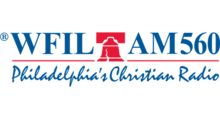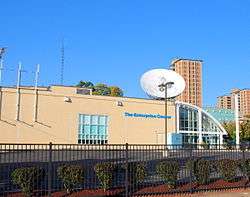WFIL
WFIL (560 AM) is an AM radio station in Philadelphia, Pennsylvania, United States, owned by Salem Media Group and broadcasting with a Christian radio format consisting of teaching and talk programs. The station's studios and transmitter facilities are shared with co-owned WNTP (990 AM) in Lafayette Hill, Pennsylvania. The station's daytime coverage includes Philadelphia and portions of the Lehigh Valley in Pennsylvania, as well as parts of New Jersey and Delaware.
 | |
| City | Philadelphia, Pennsylvania |
|---|---|
| Broadcast area | Delaware Valley |
| Frequency | 560 kHz |
| Branding | Philadelphia's Christian Radio |
| Programming | |
| Format | Christian radio |
| Ownership | |
| Owner | Salem Media Group (Salem Communications Holding Corporation) |
| Sister stations | WNTP |
| History | |
| First air date | March 18, 1922 |
| Call sign meaning | combination of predecessor stations WFI and WLIT |
| Technical information | |
| Facility ID | 52193 |
| Class | B |
| Power | 5,000 watts |
| Transmitter coordinates | 40°05′42.00″N 75°16′38.00″W |
| Links | |
| Webcast | Listen LivePLS Link |
| Website | www |
WFIL is immediately adjacent to sister station WMCA (at 570) in New York City, and the two stations have similar histories: both were Top 40 stations in the 1960s, both underwent a format evolution as AM radio faded as a music medium, and both have a Christian/religious format today. WFIL and WMCA are both 5,000-watt radio stations, but each one puts less than 5 kW of power in the specific direction of the other, because they are located next to each other on the dial, and are not allowed, by the Federal Communications Commission (FCC), to interfere with each other. Both stations also maintained Call For Action telephone help lines, being among the first radio stations in the United States to do so. The telephone number of WFIL's Call For Action line was GReenwood 7-5312. (Under the present-day North American Numbering Plan, the primary telephone numbering plan in the United States, this number would have corresponded to (215) 477-5312.)
History
WFIL was formed by a merger of two stations that were launched in 1922. One used the call letters WFI; the other was originally WDAR. Each was owned by a major Philadelphia department store; WFI was operated by Strawbridge and Clothier, while WDAR was run by Lit Brothers. While operated independently of each other, the two were able to work out amicable share-time agreements (hundreds of other American stations at the time were unable to do so, and frequently engaged in "jamming wars"). Around 1924, WDAR applied for and received the custom call-sign WLIT. By the late 1920s, the two stations were working jointly on various programs, promotions, and sponsorship efforts. In 1935, the two operators agreed to merge with each department store having representation on the new board of directors. The new call-sign became WFIL, a combination of the two previous identifiers (the fact that the new call letters were close to a phonetic spelling of "Philadelphia" was merely a happy coincidence). The new WFIL was an affiliate of NBC; some sources say the station never became established as either a "basic Red" or "basic Blue" outlet, but at least one early WFIL advertisement claimed that it was a "basic Blue" station. Westinghouse's KYW had replaced WFI-WLIT as the NBC primary for Philadelphia when it moved in from Chicago, Illinois a few years before. Starting in December 1944 the station produced Hayloft Hoedown, picked up by ABC Radio in 1945.
WFIL was purchased in 1947 by Walter Annenberg's Triangle Publications, which also owned The Philadelphia Inquirer. By then WFIL was an affiliate of the newly named ABC Radio Network. WFIL's sister stations under Triangle Publications ownership were WFIL-FM and WFIL-TV in Philadelphia; WNHC AM-FM-TV in New Haven, Connecticut; KFRE AM-FM-TV in Fresno, California; WFBG AM-FM-TV in Altoona, Pennsylvania; WNBF AM-FM-TV in Binghamton, New York; and WLYH-TV in Lancaster/Lebanon, Pennsylvania. Triangle Publications sold WFIL AM-FM-TV to Capital Cities Broadcasting in 1971 with the radio stations spun off to new owners, WFIL to LIN Broadcasting and WFIL-FM to Richer Communications which changed the call letters to WIOQ. WFIL-TV took on the new call letters of WPVI-TV.
WFIL Studio | |
 | |
   | |
| Location | 4548 Market St. Philadelphia, Pennsylvania |
|---|---|
| Coordinates | 39°57′28.56″N 75°12′47.08″W |
| Built | 1948 |
| Architect | Savery, Scheetz & Gilmour; Levy, Abraham |
| Architectural style | Moderne, Other |
| NRHP reference No. | 86002092[1] |
| Added to NRHP | July 28, 1986 |
Emergence of two rock and roll legends
Studios for the early WFIL radio stations were in the Widener Building in downtown Philadelphia. Under Triangle Publications' ownership the stations were moved to a new broadcast facility at 46th and Market Street in West Philadelphia adjacent to the Arena, the first broadcast facility in the nation specifically designed for television broadcasting. It was in this new broadcast center that Triangle began broadcasting Bandstand (later called American Bandstand), first with Bob Horn, then with Dick Clark as host. Clark started on WFIL radio as a disc jockey in 1952, arriving from Utica, New York. He continued hosting the TV program for 31 years, the last 30 as a national show carried by the ABC Television Network. Clark moved the program to Hollywood in 1964.
Shortly after Clark's emergence on the national stage, he became a major figure in the early days of rock and roll as "Bandstand" proved pivotal in helping promote the major stars of the era.
The WFIL studio at 4548 Market Street was listed on the National Register of Historic Places in 1986 for its significance as one of the first buildings constructed specifically for television broadcasting, as well as being the site for American Bandstand.[2]
Settling into a new home
In February 1964, Triangle moved the WFIL stations to a new state-of-the-art broadcast center at the corner of City and Monument Avenues in Philadelphia, from which WPVI continues to broadcast.
Starting on September 18, 1966, WFIL began playing "Top 40" rock and roll. It quickly became the most successful non-RKO "Boss Radio" formatted station, known locally as "The Pop Music Explosion". The original line up of air personalities, or "Boss Jocks" were scheduled as follows:
6-10am: Chuck Browning
10am-2pm: Jay Cook ("Captain Jay Cook")
2-6pm: Jim Nettleton ("Diamond Jim" Nettleton)
6-10pm: George Michael ("King George" Michael)
10pm-2am: Long John Wade
2-6am: Dave Parks ("Dave the Rave" Parks)
Weekends: Frank Kingston Smith
WFIL announcers heard in later years of the Top 40 era included Dr. Don Rose, Jim O'Brien (who later also became a WPVI-TV weather broadcaster and station personality), Dan Donovan, J. J. Jeffrey, Dick Heatherton, Tom Dooley, "Tiny" Tom Tyler, Mitch "K.C." Hill, "Big" Ron O'Brien, Kris Chandler, Geoff Richards, Joel Denver, Brother Lee Love (Alan Smith), and Banana Joe Montione.
The format evolved into an adult contemporary sound in the fall of 1977. At some point after that, the WFIL studios were relocated to Domino Lane in the Roxborough section of Philadelphia; they moved into the building of FM station WUSL, which WFIL owner LIN Broadcasting had acquired in late 1976. Growing competition from FM stations in this period did serious damage to WFIL's ratings. In September 1981 country music was tried, but this failed to reverse the downward trend. The station switched to an "oldies" format in September 1983, called "The Boss is Back," with a new line up of "Boss Jocks," playing the hits of 1955 through 1973. This format lasted until April 8, 1987, when new owner WEAZ Inc. discontinued locally originated music programming in favor of Transtar's "Oldies Channel," a satellite-delivered service. The end of live programming was marked by a production piece consisting of a portion of the song American City Suite by Terry Cashman and Tommy West interspersed with old WFIL airchecks. The "Epilogue to WFIL" was produced by Charlie Mills, who at the time was working cross-town at WPEN, and had been an avid fan of WFIL during his teen years.
In November 1987 FM stations WOGL and WIOQ both adopted oldies formats and quickly won the majority of the potential oldies audience. The Oldies Channel format continued with minimal success and listenership until 1989, when WFIL quietly began simulcasting sister station Easy 101.1 WEAZ (which had a soft adult contemporary format by then). Soon thereafter, the FM became WEAZ-FM so that WFIL could become WEAZ. In September 1991, the AM launched a mostly automated "beautiful music" format known as "Wish," a play on the old WWSH station which had a similar format in Philadelphia back in the 1970s. Then on May 26, 1993, WEAZ became WBEB while WEAZ-FM became WBEB-FM.
The AM station was sold for $4 million in October 1993 to Salem Communications (which had almost bought the station three years earlier for $6.5 million but backed out of the deal at the last minute) and on November 1, 1993, the station was renamed WPHY, with a religious format focusing on Christian talk and teaching. WBEB-FM then became WBEB and to this day, continues on with its adult contemporary format.
The Christian teaching and talk format is still in use today. When a TV station in South Carolina that had been using the WFIL call letters dropped them, Salem immediately moved to reclaim the famous call sign. The call letters officially reverted to WFIL on September 6, 1994.
In its rock-and-roll heyday, the station was known colloquially as "Famous 56" and employed the slogan "Rockin' in the Cradle of Liberty." Its 5000-watt transmitter enabled its signal to be heard as far away at times as Staten Island, the southernmost borough of New York City. During its top 40 years, WFIL also consistently showed strongly in the ratings books in nearby Wilmington, Delaware, where it has an excellent signal. In addition, WFIL was a popular listening choice in Reading and Allentown, both in Pennsylvania.
Today, WFIL is locally co-owned with Salem's WNTP (990 AM). WNTP is the former WIBG. WIBG was WFIL's main rock 'n roll rival in the late 1960s and early 1970s. The studios, offices and transmitters of both stations are located at the former WIBG complex on Ridge Pike in Whitemarsh Township, Pennsylvania.
References
- "National Register Information System". National Register of Historic Places. National Park Service. January 23, 2007.
- "National Register of Historic Places Nomination Form: WFIL Studio" (PDF). February 1986. Retrieved 2013-03-31.
External links
- WFIL in the FCC's AM station database
- WFIL on Radio-Locator
- WFIL in Nielsen Audio's AM station database

